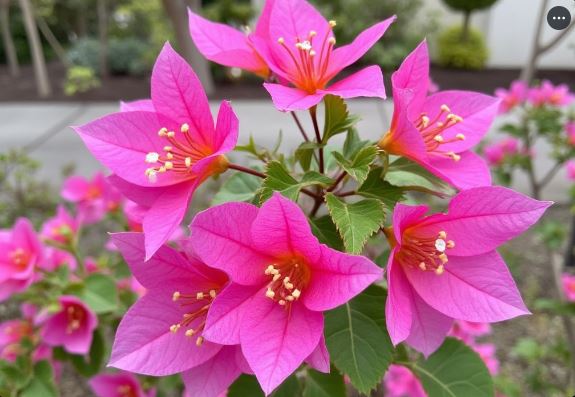
Bougainvillea ‘Barbara Karst’ is a popular hybrid cultivar known for its striking bright magenta-red bracts. It’s one of the most vigorous and fast-growing Bougainvillea varieties, often used in landscaping for its bold color and ability to thrive in hot, dry climates.
Characteristics
- Color: This cultivar is renowned for its bright magenta-red or deep pink bracts, which are often mistaken for flowers. The true flowers are small, white, and surrounded by these colorful bracts.
- Growth Habit: ‘Barbara Karst’ is known for its vigorous growth. It can grow up to 20-30 feet if given support, making it excellent for trellises, walls, or as a sprawling cover over fences and arbors.
- Leaves: The leaves are green, sometimes with a slight variegation or lighter veins, and are ovate to lanceolate in shape.
- Thorns: Like most bougainvillea, ‘Barbara Karst’ has thorns, which help it to climb but also require careful handling.
- Blooming Period: It blooms profusely in cycles throughout the warmer months. In tropical climates, it can bloom almost year-round with proper care.
- Hardiness: It is quite hardy for a bougainvillea, able to tolerate some cooler temperatures but thrives best in USDA zones 9 to 11. It can survive light frosts but will drop leaves and might experience dieback.
Cultivation
- Light: Requires full sun for the best blooming performance. At least 5 hours of direct sunlight daily is ideal.
- Soil: Well-draining soil is crucial. Sandy or loamy soils with a slightly acidic to neutral pH are preferred. They do not do well in waterlogged conditions.
- Watering: Once established, ‘Barbara Karst’ is drought-tolerant. Water deeply but infrequently, allowing the soil to dry out between waterings. Overwatering can lead to fewer blooms and root rot.
- Fertilization: Use a balanced fertilizer or one slightly higher in phosphorus to promote blooming during the growing season. However, too much nitrogen can result in lush foliage at the expense of flowers.
- Pruning: Pruning can be done after a blooming cycle to manage size and shape. This variety can handle heavy pruning, which can encourage more bushy growth and flowering.
- Support: Since it’s a climber, providing a structure like a trellis, wall, or fence will help it to grow vertically.
- Pests and Diseases: Generally resistant to pests, but can occasionally be affected by aphids, caterpillars, or snails. Root rot from overwatering is a common issue if drainage is poor.
- Cold Protection: In cooler climates, it might need protection during winter or can be grown in pots to be moved indoors. Mulching around the base can help protect the roots from cold snaps.
- Propagation: Can be propagated from semi-hardwood cuttings taken in late spring or early summer. Rooting hormone can help improve success rates.